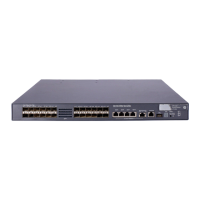91
Configuring PoE interface through PoE profile
You can configure a PoE interface either at the CLI or by using a PoE profile and applying the PoE profile
to the specified PoE interfaces.
To configure a single PoE interface, configure it at the CLI; to configure PoE interfaces in batches, use a
PoE profile.
A PoE profile is a collection of configurations that contain multiple PoE features. On large-scale networks,
you can apply a PoE profile to multiple PoE interfaces, and these interfaces have the same PoE features. If
the PoE interface connecting to a PD changes to another one, apply the PoE profile applied on the
originally connected interface to the connected interface instead of reconfiguring the features defined in
the PoE profile one by one, simplifying the PoE configurations.
The device supports multiple PoE profiles. You can define PoE configurations based on each PD, save the
configurations for different PDs into different PoE profiles, and apply the PoE profiles to the access
interfaces of PDs.
Configuring PoE profile
To do… Use the command… Remarks
1. Enter system view.
system-view —
2. Create a PoE profile, and
enter PoE profile view.
poe-profile profile-name [ index ] Required.
3. Enable PoE for the PoE
interface.
poe enable
Required.
Disabled by default.
4. Configure the maximum
power for the PoE interface.
poe max-power max-power
Optional.
30000 milliwatts by default.
5. Configure power supply
priority for the PoE interface.
poe priority { critical | high |
low }
Optional.
low by default.
CAUTION:
• If a PoE profile is applied, it cannot be deleted or modified before you cancel its application.
• The poe max-power
max-power
and poe priority { critical | high | low } commands must only be
configured in one way, either at the CLI or by configuring PoE profile.
• A PoE parameter on a PoE interface must be only configured, modified, and deleted in one way. If a
parameter configured one way (for example, at the CLI) is then confi
ured another way (for example,
through PoE profile), the latter configuration fails and the original one is still effective. To make the
latter configuration effective, you must cancel the original one first.
Applying PoE profile
You can apply a PoE profile in either system view or interface view. If you perform application to a PoE
interface in both views, the latter application takes effect. To apply a PoE profile to multiple PoE interfaces,
the system view is more efficient.

